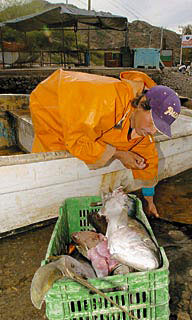|
GUAYMAS, SON. - The Sea of Cortez is in danger.
Divers and scientists here say they're seeing fewer big fish, shark and turtles in the waters Jacques Cousteau once called the "aquarium of the world." Captains and fishermen, too, say their catches are smaller.
It's all part of a global overfishing phenomenon that has devastated the world's big fish populations, according to a recent study of fishing records dating to the industry's boom in the 1950s.
"No matter where you look in the world, on average, 90 percent of the fish are gone," said Ransom Myers, the biologist from Dalhousie University in Canada who analyzed the records.
It's no surprise to Tucson sport fishermen who seek big fish such as marlins and mahi-mahi on weekend escapes to the Sea of Cortez, also known as the Gulf of California. Nor is it surprising to Mexican fishermen living on these shores who depend on their catch for survival.
Both see the impact of a disappearing world.
"So far, no extinctions, yet," said retired University of Arizona marine biology/oceanography Professor Donald A. Thomson, who has studied the Sea of Cortez since 1963. "But it'll eventually happen unless we do something about it."
Concern for the sea has grown so much that this week - from yesterday through Thursday - in Tucson, 350 experts are participating in the largest ever Gulf of California conference.
Fishermen, divers and scientists aside, declining fish populations here lead to other problems ranging from seafood prices to illegal immigration.
"Overfishing makes it more difficult for future generations to eat fish," Thomson said. "They're depleting a natural resource and it may not be able to come back."
Though some fishing techniques used in Mexico are banned or tightly controlled in the United States because of their potential to harm ecosystems, the catch often still winds up on our plates, feeding a growing appetite for seafood. From 2001 to 2002, Americans' per-capita consumption of seafood rose 7.1 percent, to 15.6 pounds.
According to the U.S. Department of Agriculture's statistics, almost 900 million pounds of fish products caught in Mexico were shipped to the United States from 1999-2003. More than 317 million pounds were shrimp.
'25 years ago it was unbelievable here. You could sit on a rock and the fish would come to you.' - Tucson diver Mike Huhn
Longlines, often stretching more than a mile with hundreds of hooks, nab marlin, mahi-mahi, swordfish, sea birds and endangered sea turtles. Along with turtles, marine mammals such as sea lions, dolphin and even whales get caught and killed in gill nets.
Mexican fishermen here use gill nets, which are banned or tightly regulated in the United States, and longlines, which were recently banned in California, according to Brendan Cummings, a lawyer with the Center for Biological Diversity.
While 41-year-old Mexican fisherman Mario Cordoba's nets and hooks are cast in search of sea bass and bottom fish, if he catches a turtle, he can sell it for more than three times what he gets for fish, he said.
Relates articles from the Tuscon Citizen
Sharks, turtles disappearing
Fisherman's take from Sea of Cortez: squid
Lax laws and enforcement killing Cortez
Top
|
